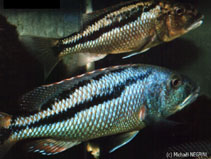| Family: |
Cichlidae (Cichlids), subfamily: Pseudocrenilabrinae |
| Max. size: |
30 cm TL (male/unsexed) |
| Environment: |
benthopelagic; freshwater; pH range: 7.40000009536743 - 8.39999961853027; dH range: 7 - 30; depth range 2 - 10 m |
| Distribution: |
Africa: Endemic to Lake Malawi; widespread but uncommon. |
| Diagnosis: |
Description: oral teeth small and simple; pharyngeal jaw stout and very deep though not particularly large, with few strong teeth (Ref. 55954). |
| Biology: |
Found mainly in places where rock and sand form an intermediate biotope. Females which are solitary like males can enter the male's territory found among rocks, and spawn (Ref. 5595). Feed on fish fry (Ref. 267). When feeding, it turns on its side to place its large, laterally compressed jaws into rocky cracks where it captures small fish that are sheltering there (Ref. 6307). |
| IUCN Red List Status: |
Least Concern (LC); Date assessed: 22 June 2018 Ref. (130435)
|
| Threat to humans: |
harmless |
Source and more info: www.fishbase.org. For personal, classroom, and other internal use only. Not for publication.

